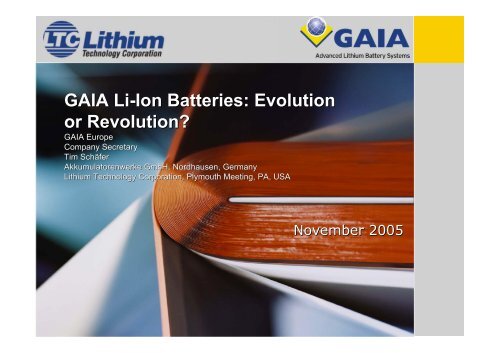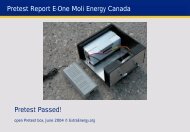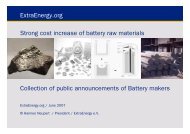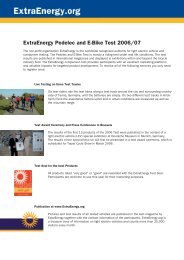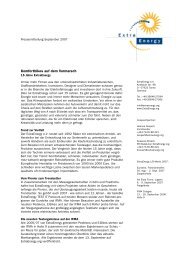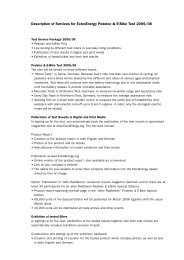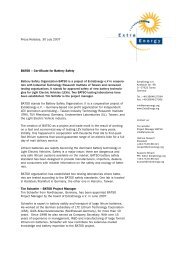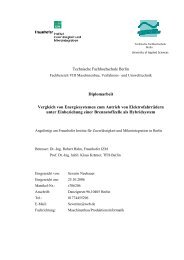GAIA Li-Ion Batteries: Evolution or Revolution? - ExtraEnergy.org
GAIA Li-Ion Batteries: Evolution or Revolution? - ExtraEnergy.org
GAIA Li-Ion Batteries: Evolution or Revolution? - ExtraEnergy.org
Create successful ePaper yourself
Turn your PDF publications into a flip-book with our unique Google optimized e-Paper software.
<strong>GAIA</strong> <strong>Li</strong>-<strong>Ion</strong> <strong>Batteries</strong>: <strong>Evolution</strong><br />
<strong>or</strong> <strong>Revolution</strong>?<br />
<strong>GAIA</strong> Europe<br />
Company Secretary<br />
Tim Schäfer<br />
Akkumulat<strong>or</strong>enwerke GmbH, N<strong>or</strong>dhausen, N<strong>or</strong>dhausen,<br />
Germany<br />
<strong>Li</strong>thium Technology C<strong>or</strong>p<strong>or</strong>ation, Plymouth Meeting, PA, USA<br />
November 2005
Proprietary Inf<strong>or</strong>mation, November,2005<br />
Overview<br />
Company Overview<br />
Technology<br />
Manufacturing Process<br />
Product P<strong>or</strong>tfolio<br />
Target Markets<br />
Hybrid Electrical Vehicle Battery<br />
• Cell Level<br />
- Discharge Perf<strong>or</strong>mance<br />
- Cycle <strong>Li</strong>fe<br />
- Calendar <strong>Li</strong>fe and Self Discharge<br />
- Safety Aspects<br />
• Battery Management System<br />
• Battery Level<br />
- Design of 288V Battery and Prototype<br />
- Pulse Power Perf<strong>or</strong>mance<br />
• Applications<br />
Developments<br />
Summary
Company Overview
Proprietary Inf<strong>or</strong>mation, November,2005<br />
Hist<strong>or</strong>y<br />
April 1996 Founding of <strong>GAIA</strong><br />
1997 Proprietary extrusion process<br />
1998 Arch Hill, a Dutch venture capital<br />
company, acquires maj<strong>or</strong>ity share of <strong>GAIA</strong><br />
1999 Installation of three pilot extrusion lines<br />
2000 Refinement of battery production facilities<br />
2002 Merger of <strong>GAIA</strong> and LTC<br />
2003 Market entry with large f<strong>or</strong>mat <strong>Li</strong>thium<br />
ion cells<br />
2005 Market entry with <strong>Li</strong>thium ion batteries
Proprietary Inf<strong>or</strong>mation, November,2005<br />
C<strong>or</strong>p<strong>or</strong>ate Structure<br />
<strong>Li</strong>thium Technology C<strong>or</strong>p<strong>or</strong>ation is a Public US C<strong>or</strong>p<strong>or</strong>ation<br />
traded on the OTC Bulletin Board (LTHU.OB)<br />
LTC and <strong>GAIA</strong> were merged in 2002 combining two<br />
synergistic technologies<br />
(US Operations)<br />
Plymouth Meeting<br />
Pennsylvania (USA)<br />
<strong>Li</strong>thium Technology C<strong>or</strong>p<strong>or</strong>ation<br />
Plymouth Meeting<br />
Pennsylvania (USA)<br />
<strong>GAIA</strong> Akkumulat<strong>or</strong>enwerke, GmbH<br />
N<strong>or</strong>dhausen<br />
Thuringia (Germany)
Proprietary Inf<strong>or</strong>mation, November,2005<br />
Facilities<br />
US Operations<br />
(LTC - Plymouth Meeting)<br />
• C<strong>or</strong>p<strong>or</strong>ate Headquarters<br />
• US Government/Military<br />
Development Contracts<br />
• R & D and cooperative<br />
programs with US raw<br />
material suppliers<br />
• US Sales<br />
• Battery design and assembly<br />
using <strong>GAIA</strong> cells<br />
• <strong>Li</strong>mited contract production<br />
of specialty flat cells<br />
European Operations<br />
(<strong>GAIA</strong> - N<strong>or</strong>dhausen)<br />
• European Development<br />
Contracts<br />
• R & D and cooperative<br />
programs with EU raw<br />
material suppliers<br />
• European Sales<br />
• Commercial Production of<br />
cylindrical cells<br />
• Battery design and<br />
assembly
Proprietary Inf<strong>or</strong>mation, November,2005<br />
Current Operations<br />
Small Production/Large Pilot Scale Operation<br />
•57 Employees (17 in US, 40 in Germany)<br />
•FACILITIES<br />
• 176,000 ft 2 facility in N<strong>or</strong>dhausen, Germany<br />
• 13,000 ft 2 facility in Plymouth Meeting, PA, USA<br />
• PRODUCTS:<br />
• Custom engineered batteries<br />
• Development contracts<br />
• Cylindrical and prismatic <strong>Li</strong>thium-<strong>Ion</strong> cells<br />
- from 5 Ah to 120 Ah
<strong>GAIA</strong> Technology
Proprietary Inf<strong>or</strong>mation, November,2005<br />
Principle of <strong>Li</strong>thium <strong>Ion</strong> <strong>Batteries</strong><br />
–<br />
e -<br />
e -<br />
e -<br />
Discharge Current I<br />
Copper<br />
neg. Collect<strong>or</strong><br />
(Anode)<br />
<strong>Li</strong> x C 6<br />
A<br />
<strong>Li</strong> + conductive<br />
Electrolyte<br />
<strong>Li</strong> +<br />
<strong>Li</strong> +<br />
<strong>Li</strong> +<br />
<strong>Li</strong> +<br />
<strong>Li</strong> +<br />
<strong>Li</strong> 1-x MO 2<br />
Charge Current I<br />
e -<br />
e -<br />
e -<br />
Aluminium<br />
pos. Collect<strong>or</strong><br />
(Cathode)<br />
+
Proprietary Inf<strong>or</strong>mation, November,2005<br />
Technological Advantages of <strong>Li</strong>thium-<strong>Ion</strong> over other<br />
Chemistries<br />
Energy per Weight<br />
Energy per Volume<br />
Power per Weight<br />
Power per Volume<br />
Fast Charge<br />
Heat Generation<br />
Operational<br />
Temperature Range<br />
Battery Complexity<br />
(Number of Cells)<br />
Lead Acid<br />
1<br />
1<br />
1<br />
1<br />
Po<strong>or</strong><br />
High<br />
Narrow<br />
Medium<br />
(2V per cell)<br />
NiMH<br />
2 x<br />
1.5 x<br />
5 to 10 x<br />
3 to 6 x<br />
Good<br />
Low<br />
Wide<br />
High<br />
(1.2V per cell)<br />
<strong>Li</strong>_<strong>Ion</strong><br />
3 x<br />
2 x<br />
5 to 15 x<br />
3 to 10 x<br />
Very Good<br />
Very Low<br />
Very Wide<br />
Low<br />
(3.6V per cell)
Proprietary Inf<strong>or</strong>mation, November,2005<br />
LTC Differentiat<strong>or</strong>s<br />
Proprietary cell design IP<br />
• Low internal resistance allows f<strong>or</strong> high power output and<br />
rapid charging with limited heat generation<br />
Proprietary manufacturing process<br />
• Lower cost extrusion and assembly allows scalability and<br />
opp<strong>or</strong>tunity f<strong>or</strong> high gross margins<br />
• Environmentally friendly (no solvents)<br />
Patents<br />
• Issued 33<br />
• Applications Pending 42
Proprietary Inf<strong>or</strong>mation, November,2005<br />
<strong>Li</strong>-<strong>Ion</strong> Technology<br />
I II III IV V<br />
I: Al-Collect<strong>or</strong> (18-25 m)<br />
II: Positive Electrode (40-200 m)<br />
III: Separat<strong>or</strong> (16 – 35 m)<br />
IV: Negative Electrode (30-150 m)<br />
V: Cu-Collect<strong>or</strong> (12-20 m)
Manufacturing Process
Proprietary Inf<strong>or</strong>mation, November,2005<br />
Process - Extrusion<br />
graphit, polymers<br />
and carbon black<br />
mixing and drying of<br />
anode materials<br />
<strong>Li</strong>CoO2,<br />
polymers and<br />
carbon black<br />
mixing and drying of<br />
cathode materials<br />
y g g y y<br />
dry blend<br />
anode<br />
dry blend<br />
cathode<br />
electrolyte<br />
electrolyte<br />
polymer anode<br />
on carrier foil<br />
polymer cathode<br />
on carrier foil<br />
No emission of solvents<br />
Safe and environmental<br />
No ex-proof installation<br />
Cost-effective<br />
Co-extrusion of polymer blends
Proprietary Inf<strong>or</strong>mation, November,2005<br />
Process - Lamination<br />
anode<br />
material on<br />
carrier foil<br />
1<br />
lamination of<br />
anode<br />
laminate of<br />
anode / Cu / anode
Proprietary Inf<strong>or</strong>mation, November,2005<br />
Processing Technology - Winding & Assembling<br />
cell winding machine<br />
anode polymer electrolyte<br />
polymer electrolyte<br />
cathode<br />
cathode current<br />
collect<strong>or</strong> "Al"<br />
lid with<br />
terminals<br />
laser welding<br />
anode current<br />
collect<strong>or</strong> "Cu"<br />
tab and lid<br />
assembly<br />
housing
<strong>GAIA</strong> Product P<strong>or</strong>tfolio
Proprietary Inf<strong>or</strong>mation, November,2005<br />
<strong>GAIA</strong> Product P<strong>or</strong>tfolio<br />
Present cylindrical cells<br />
range in capacity from 5 Ah to<br />
60 Ah<br />
<strong>GAIA</strong> offers two basic types<br />
of products tayl<strong>or</strong>ed to<br />
different applications<br />
• The HE product series is optimized towards high energy content<br />
with moderate rate capability (continuous discharge up to 2C)<br />
• The HP and UHP series are designed to deliver maximum power<br />
(continuous discharge up to 10C)<br />
<strong>GAIA</strong> has developed battery packs of up to 600V to customer<br />
specifications
Proprietary Inf<strong>or</strong>mation, November,2005<br />
Battery Systems Comparison - Ragone Plot
Proprietary Inf<strong>or</strong>mation, November,2005<br />
Large, High Power Engineered <strong>Li</strong>thium <strong>Ion</strong> Is LTC’s C<strong>or</strong>e<br />
Expertise<br />
<strong>GAIA</strong> cells offer the highest power of any commercial<br />
lithium ion cell in the western hemisphere* (most amperes<br />
<strong>or</strong> watts per kilogram)<br />
• <strong>GAIA</strong> UHP product achieves 2400 W/kg (pulse)<br />
<strong>GAIA</strong> cells are the largest lithium ion cells produced in the<br />
western hemisphere (most energy capacity - watt-hours <strong>or</strong><br />
amp hours)<br />
• <strong>GAIA</strong> HE-602050 has 60 Ah <strong>or</strong> 216 Wh c<strong>or</strong>responding to 150<br />
Wh/kg<br />
• 120 Ah cell is in development<br />
LTC specializes in w<strong>or</strong>king with the customer to engineer<br />
solutions using standardized cells in customized<br />
configurations<br />
• Custom engineered battery packs including electronic battery<br />
management systems<br />
* US and EU companies have an advantage selling the western hemisphere being<br />
domestic suppliers and it is unrealistic f<strong>or</strong> US and EU companies to sell into Asia.
<strong>GAIA</strong> Markets
Proprietary Inf<strong>or</strong>mation, November,2005<br />
Markets with Projected Growth in Advanced <strong>Batteries</strong><br />
Military/National<br />
Security<br />
Applications require<br />
flexibility in design, wide<br />
ranges of power output,<br />
broad operating<br />
temperatures, low weight<br />
and thousands of recharge<br />
cycles. Perf<strong>or</strong>mance is m<strong>or</strong>e<br />
imp<strong>or</strong>tant than price.<br />
Market need is growing<br />
quickly. Development<br />
funding is available.<br />
Transp<strong>or</strong>tation<br />
Applications require rapid<br />
charging rates and long<br />
life in safe, durable high<br />
power st<strong>or</strong>age f<strong>or</strong> HEV, EV<br />
and fuel cell powered<br />
vehicles. Military, heavy<br />
duty and niche vehicle<br />
OEMs are early adopters.<br />
Immediate niches exist.<br />
Stationary Power<br />
Growing dependence on<br />
electrical power w<strong>or</strong>ldwide<br />
drives the demand f<strong>or</strong> high<br />
quality high-reliability power<br />
f<strong>or</strong> telecommunications,<br />
computers, mission critical<br />
applications, remote mobile<br />
and renewable power<br />
applications. Very large<br />
potential market.
Proprietary Inf<strong>or</strong>mation, November,2005<br />
Military/ National Security Market<br />
The US and its allies are changing the military<br />
landscape. The trend is to many small, rapidly deployed<br />
units using extensive power-intensive electronics.<br />
Applications already exist in this market and continue<br />
to grow rapidly.<br />
• Unmanned reconnaissance and combat supp<strong>or</strong>t systems<br />
-- airb<strong>or</strong>ne, ground, underwater<br />
• Satellite surveillance and communications systems<br />
• Remotely controlled surveillance, detection and demolition robots<br />
• Manned combat supp<strong>or</strong>t vehicles -- land-based and underwater<br />
• “Silent Watch” (stealth operations on battery power only)<br />
• Night goggles, communications equipment, GPS, computers,<br />
handheld spotlights, etc.
Proprietary Inf<strong>or</strong>mation, November,2005<br />
Transp<strong>or</strong>tation Market<br />
American and European auto manufacturers are now<br />
taking the Japanese HEV eff<strong>or</strong>t seriously<br />
• Existing applications (lithium ion SLI [starting, lighting & ignition] batteries)<br />
- Mot<strong>or</strong>cycles<br />
- Racing cars<br />
- Certain very high end automobiles – dual battery systems<br />
• Developing applications / trends (HEVs,EVs)<br />
- Wheelchairs<br />
- Taxies<br />
- City delivery vans<br />
- All terrain vehicles (ATVs) & snowmobiles f<strong>or</strong> national parks<br />
- Professional lawn and garden<br />
- Neighb<strong>or</strong>hood electric vehicles (NEVs)
Proprietary Inf<strong>or</strong>mation, November,2005<br />
Stationary Power Market<br />
Growing dependence on digital devices f<strong>or</strong> mission<br />
critical applications drives demand f<strong>or</strong> uninterrupted<br />
(distributed) power and backup power. <strong>Li</strong>fe cycle value<br />
of lithium ion over lead acid is a key market advantage.<br />
• Existing applications<br />
- Telecom: lower cost of cooling/heating the facilities; less maintenance;<br />
remote monit<strong>or</strong>ing<br />
- Solar: less maintenance, longer battery life<br />
- UPS: space/weight savings, higher reliability, less maintenance,<br />
longer life and lower life cycle cost<br />
• Developing applications / trends<br />
- New wireless netw<strong>or</strong>k installations with lower cost infrastructure<br />
- Heightened awareness of need f<strong>or</strong> backup systems following st<strong>or</strong>ms and<br />
blackouts<br />
- Wind and solar power
Proprietary Inf<strong>or</strong>mation, November,2005<br />
Rechargeable Battery Market Size f<strong>or</strong> National Security,<br />
Transp<strong>or</strong>tation, and Stationary Power<br />
2003 2011<br />
Conventional Advanced Total Conventional Advanced Total<br />
Transp<strong>or</strong>tation $ 8,000 $ 50 $ 8,050 $ 7,400 $ 1,400 $ 8,800<br />
National Security $ 2,000 $ 200 $ 2,200 $ 2,200 $ 500 $ 2,700<br />
Stationary Power $ 5,000 $ 50 $ 5,050 $ 6,500 $ 250 $ 6,750<br />
Total $ 15,000 $ 300 $ 15,300 $ 16,100 $ 2,150 $ 18,250<br />
Continuous growth of the advanced market over 700% in 8 years<br />
Within the advanced market, lithium ion will grow faster than competing<br />
chemistries<br />
Sources: Frost & Sullivan, LTC investigations<br />
Conventional: Lead-Acid<br />
Advanced: <strong>Li</strong>-<strong>Ion</strong>, NiCd, NiMH
Proprietary Inf<strong>or</strong>mation, November,2005<br />
Partnerships that have Developed as a Result of Our<br />
Demonstrated Capabilities<br />
<strong>GAIA</strong> GmbH has entered into a contract with a<br />
European submarine manufacturer to jointly develop<br />
and supply very large lithium ion cells f<strong>or</strong><br />
underwater non-nuclear submarine propulsion<br />
LTC has signed a contract with a maj<strong>or</strong> US battery<br />
company to develop and supply rack-mounted<br />
backup power supplies<br />
LTC is discussing a joint venture arrangement with a<br />
small European EV/HEV manufacturer to supply<br />
batteries f<strong>or</strong> inclusion in the drive train f<strong>or</strong> HEVs/EVs
HP-341450 Cell f<strong>or</strong><br />
Hybrid Electrical Vehicle Battery
Proprietary Inf<strong>or</strong>mation, November,2005<br />
Cells f<strong>or</strong> HEV <strong>Batteries</strong><br />
DD cell UHP341450 "7.5Ah"<br />
Diameter 34 mm<br />
Height (w/o terminals) 145 mm<br />
Weight 320 g<br />
Volume (w/o terminals) 132 cm3 Case material Stainless steel
Proprietary Inf<strong>or</strong>mation, November,2005<br />
<strong>GAIA</strong> 7.5Ah DD HEV Cells<br />
Discharge Curves: 20°C at Different Rates<br />
Voltage / V<br />
4.5<br />
4<br />
3.5<br />
3<br />
2.5<br />
2<br />
DD646<br />
C-Rate<br />
0.4 1 2 3 5 7 9 10<br />
12 14 15 17 19 21<br />
0 2 4<br />
Discharge Capacity / Ah<br />
6 8
Proprietary Inf<strong>or</strong>mation, November,2005<br />
Discharge Curves: C/2 at Different Temperatures<br />
Voltage / V<br />
4.5<br />
4<br />
3.5<br />
3<br />
2.5<br />
2<br />
DD646<br />
temperature during test / °C<br />
~40°C<br />
0 2 4 6 8<br />
Discharge Capacity / Ah<br />
-30<br />
-20<br />
0<br />
20
Proprietary Inf<strong>or</strong>mation, November,2005<br />
HP341450: 250A Pulse f<strong>or</strong> 500ms<br />
Current(A)<br />
500<br />
400<br />
300<br />
200<br />
100<br />
0<br />
-100<br />
-200<br />
1-001 Current(A)<br />
1-001 Voltage(V)<br />
~2400W/kg<br />
-300<br />
0<br />
44000 44500 45000 45500 46000 46500 47000 47500 48000<br />
Test_Time(s)<br />
4.5<br />
4<br />
3.5<br />
3<br />
2.5<br />
2<br />
1.5<br />
1<br />
0.5<br />
Voltage(V)
Proprietary Inf<strong>or</strong>mation, November,2005<br />
Cycle Perf<strong>or</strong>mance at 100% DoD<br />
Capaccity / % of C ini<br />
100%<br />
80%<br />
60%<br />
40%<br />
20%<br />
0%<br />
Charge: C/2 to 4.2V, taper to C/10<br />
Discharge: 1 min @ 4C, than 1C to 3V<br />
0 200 400 600 800 1000<br />
Cycle
Proprietary Inf<strong>or</strong>mation, November,2005<br />
Cycling Experiments (Summary)<br />
Capacity / x-fold C nom<br />
100000<br />
10000<br />
1000<br />
100<br />
extrapolated, no fade<br />
after 300k 1% cycles<br />
4.5C CHR<br />
and 3C DCH<br />
3C CHR and<br />
3C DCH<br />
extrapolated after<br />
22k cycles<br />
1 10 100<br />
DOD / %<br />
Min<br />
Max<br />
C/2 CHR and<br />
~1C DCH
Proprietary Inf<strong>or</strong>mation, November,2005<br />
Calendar <strong>Li</strong>fe & Self Discharge<br />
Capacity / Ah<br />
6<br />
5<br />
4<br />
3<br />
2<br />
1<br />
0<br />
<strong>Li</strong>NiCoO2/MCMB System<br />
20°C 40°C<br />
Capacity<br />
rev. Capacity loss<br />
0 50 100 150<br />
Time / days<br />
200 250<br />
0<br />
300<br />
60<br />
50<br />
40<br />
30<br />
20<br />
10<br />
rev. Cap. loss / % per month
Proprietary Inf<strong>or</strong>mation, November,2005<br />
Safety Tests on Cell Level<br />
Electrical Tests<br />
Sh<strong>or</strong>t Circuit at RT<br />
Sh<strong>or</strong>t Circuit at<br />
Abn<strong>or</strong>mal 60°C* Charge<br />
Abn<strong>or</strong>mal Discharge<br />
Mechanical Tests<br />
Crush<br />
Impact<br />
Shock*<br />
Vibration<br />
Fall<br />
Environmental Tests<br />
Temperature Cycling<br />
Heating*<br />
Altitude Simulation<br />
temperature rise<br />
sparks and smoke<br />
small def<strong>or</strong>mation<br />
small dent<br />
de-contacting<br />
small dents<br />
<br />
<br />
**<br />
<br />
<br />
<br />
<br />
<br />
<br />
<br />
<br />
<br />
Acc<strong>or</strong>ding<br />
to UL1642<br />
and ADR<br />
Summary of tests on<br />
7.5 and 60Ah cells<br />
*small variation to<br />
the standard<br />
** not a requirement<br />
on the cell level
Battery Management System
Proprietary Inf<strong>or</strong>mation, November,2005<br />
Justification f<strong>or</strong> the Battery Management System<br />
The recommended battery charging method is IUcharging<br />
(const. current, const. voltage)<br />
But:<br />
• In a serial string the charger can not control individual<br />
cell voltages.<br />
• <strong>Li</strong>-<strong>Ion</strong> cells do not tolerate overcharging with<br />
“elevated” voltages f<strong>or</strong> balancing the cells<br />
(e.g. “float <strong>or</strong> boost charging”)<br />
• Abuse <strong>or</strong> operation out of range could result in safety<br />
issues by thermal runaway<br />
<strong>Li</strong>-<strong>Ion</strong> <strong>Batteries</strong> require a battery management<br />
system (BMS) <strong>or</strong> an electronic protection circuit
Proprietary Inf<strong>or</strong>mation, November,2005<br />
Block Diagram of BMS<br />
SOC<br />
SOH<br />
Data acquisition<br />
U I T R<br />
Energy<br />
management<br />
Safety management<br />
Thermal<br />
management<br />
Fan, etc..<br />
Comm.<br />
unit<br />
Contact<strong>or</strong><br />
Battery<br />
CAN<br />
Load &<br />
Charger
Proprietary Inf<strong>or</strong>mation, November,2005<br />
Sens<strong>or</strong>s<br />
& main<br />
switch<br />
Example of 10S BMS Hardware<br />
Current sens<strong>or</strong><br />
130 cm 2<br />
CAN<br />
interface<br />
P<br />
Master Slave (10S)<br />
RS232 f<strong>or</strong><br />
flashing<br />
Master<br />
Optically<br />
decoupled<br />
RS485 bus<br />
P<br />
to cells<br />
40 cm 2<br />
MUX
288V Hybrid Electrical Vehicle Battery<br />
with 80S HP-341450 Cell
Proprietary Inf<strong>or</strong>mation, November,2005<br />
288V HEV Battery with 2kWh<br />
Weight of cell 0.32 kg<br />
Number of cells 80<br />
Packaging 30 %<br />
Weight today 42 kg<br />
Weight 33 kg<br />
Length 700 mm<br />
Width 292 mm<br />
Height 195 mm<br />
Volume 40 L<br />
Power (18s) 25 kW
Proprietary Inf<strong>or</strong>mation, November,2005<br />
“Peukert” Plot of a Simulated HEV Battery<br />
Cont. discharge time / s<br />
10000<br />
1000<br />
100<br />
10<br />
1<br />
40°C<br />
20°C<br />
0°C<br />
-20°C<br />
-30°C<br />
of 288V HEV battery<br />
Power calculated with BSF=80<br />
Cold<br />
Cranking<br />
Power<br />
PNGV<br />
Power Assist<br />
DC HEV<br />
Spec<br />
PNGV<br />
Dual<br />
Mode<br />
FreedomCar<br />
1 10<br />
Power / kW<br />
100
Proprietary Inf<strong>or</strong>mation, November,2005<br />
Hybrid Pulse Power Test<br />
Current / I max<br />
1<br />
0<br />
-1<br />
DM PA<br />
OCV<br />
Discharge<br />
Regen<br />
OCV<br />
PA<br />
DM<br />
0 10203040506070<br />
Time / sec<br />
Hybrid Pulse Power Characterization<br />
(HPPC)<br />
PNGV Battery Test Manual, Feb., 2001<br />
FreedomCAR Battery Test Manual F<strong>or</strong> Power-<br />
Assist HEV, Oct., 2003<br />
Discharge<br />
C/1<br />
Regen<br />
Time<br />
10%<br />
C/1<br />
HPPC Profiles<br />
10%<br />
C/1
Proprietary Inf<strong>or</strong>mation, November,2005<br />
Cells: Resistance and OCV<br />
BSF = 80
Proprietary Inf<strong>or</strong>mation, November,2005<br />
Battery 288V: HPPC Profile<br />
Discharge Power / kW<br />
70<br />
60<br />
50<br />
40<br />
30<br />
20<br />
10<br />
0<br />
100<br />
10s<br />
18s<br />
measurement by ZSW<br />
~ 1600W/kg<br />
80<br />
FreedomCAR Requirements<br />
=> ca. 20..80% SOC, >1kWh<br />
60<br />
40<br />
State of Charge / %<br />
~ 1400W/kg<br />
20<br />
10 s CHR<br />
18 s CHR<br />
10 s DCH<br />
18 s DCH<br />
10s<br />
18s<br />
CHR<br />
0<br />
60<br />
50<br />
40<br />
30<br />
20<br />
10<br />
0<br />
Charge Power / kW
Proprietary Inf<strong>or</strong>mation, November,2005<br />
Gap Analysis to USABC requirements<br />
PNGV FreedomCar<br />
Chara cteristic Unit PA PA Min 42V SS achieved<br />
Pulse Discharge kW 18sec@25 10sec@25 2sec@6 70<br />
Pulse Charge (regen) kW 2sec@30 10sec@20 N/A 55<br />
Available Energy kWh 0.3 (@ C/1) 0.3 (@C/1) 0.25 (@3kW) 1<br />
Efficiency round-trip % 90 (25Wh) 90 (25Wh) 90 95<br />
Cold Cranking @ –30°C<br />
(3x 2sec, 10 sec. rests)<br />
Cycle <strong>Li</strong>fe Cycles 300k total<br />
7.5MWh<br />
kW 5 5 8 (21V Cold<br />
Start Profile)<br />
300k total<br />
7.5MWh<br />
150k ZPA<br />
450k Starts<br />
10<br />
>300k<br />
Calendar <strong>Li</strong>fe Years 15 6-8<br />
Weight / Volume kg / L 40 / 32 40 / 32 10 / 9 42/40<br />
Max. Voltage V 440 400 48 (OCV) 336<br />
Min. Voltage V 0.55*V max 0.55*V max 27 185<br />
Max. Self Discharge Wh/Day 50 20 5%/m=4<br />
Operation Temperature °C -30 to +52 (-30 to 40°C) -30..40<br />
St<strong>or</strong>age Temperature °C -46 to +66 (-40 to 60°C)<br />
Cost $ 300/kWh 500/unit 150/unit m<strong>or</strong>e<br />
288 V / 2.1 kWh HEV Battery
Hybrid Electric Vehicle Profile
Proprietary Inf<strong>or</strong>mation, November,2005<br />
Specification f<strong>or</strong> HEV-Bus: 100kW with 45Ah Cells<br />
1C Cycle<br />
Cells<br />
Height<br />
Width<br />
Length<br />
Volume<br />
Weight Cells<br />
Packaging<br />
Weight<br />
single 27Ah cell<br />
160<br />
320<br />
500<br />
1070<br />
171<br />
232<br />
25<br />
290<br />
mm<br />
mm<br />
mm<br />
l<br />
kg<br />
%<br />
kg
Developments
Proprietary Inf<strong>or</strong>mation, November,2005<br />
Capacity / Ah<br />
Cycling Data of <strong>Li</strong>FePO 4 System<br />
6<br />
5<br />
4<br />
3<br />
2<br />
1<br />
0<br />
cycling after deep discharge<br />
Cycle profile:<br />
CHR: 0.8C rate to 4.0V taper to C/20<br />
DCH: 0.8C rate to 2.5V<br />
0 200 400 600 800 1000 1200 1400 1600 1800 2000<br />
Cycles<br />
Ri Test:<br />
U/ I with<br />
5s pulse @<br />
C/10 and C/1<br />
Ri DCH<br />
Ri CHR<br />
0.14<br />
0.12<br />
0.1<br />
0.08<br />
0.06<br />
0.04<br />
0.02<br />
0<br />
Resistance / Ohm
Proprietary Inf<strong>or</strong>mation, November,2005<br />
Ragone Plot DD-size Cell<br />
spec. Energy / Wh/kg<br />
100<br />
90<br />
80<br />
70<br />
60<br />
50<br />
40<br />
30<br />
20<br />
10<br />
0<br />
-30°C<br />
<strong>GAIA</strong> HE<br />
<strong>Li</strong>FePO 4<br />
0°C<br />
20°C<br />
40°C<br />
0 100 200 300 400 500 600 700 800 900 1000<br />
spec. Power / W/kg<br />
<strong>GAIA</strong> UHP
Proprietary Inf<strong>or</strong>mation, November,2005<br />
Overcharging<br />
Change in Temp. / K<br />
150<br />
100<br />
50<br />
0<br />
Charging with 3x of the recommended charging current (1.5C-rate)<br />
<strong>Li</strong>NiCoMO 2<br />
<strong>Li</strong>FePO 4<br />
0 50 100 150 200 250 300<br />
SOC / %<br />
<strong>Li</strong>NiCoMO 2<br />
U>20V<br />
<strong>Li</strong>FePO 4<br />
20<br />
15<br />
10<br />
5<br />
0<br />
Voltage / V
Summary
Proprietary Inf<strong>or</strong>mation, November,2005<br />
Summary<br />
Large f<strong>or</strong>mat, high power engineered <strong>Li</strong>thium <strong>Ion</strong> batteries are<br />
LTC's c<strong>or</strong>e expertise<br />
• Specific pulse power up to 2400 W/kg<br />
• Specific energy up to 150 Wh/kg<br />
• Cell energy content up to 216 Wh (60 Ah)<br />
LTC delivers customers with engineered battery packs from pilot<br />
facilities in Germany and the US<br />
• Military, transp<strong>or</strong>tation and stationary markets<br />
• <strong>Batteries</strong> up to 600 V<br />
<strong>Batteries</strong> with LTC's DD High Power cell meet the perf<strong>or</strong>mance<br />
targets f<strong>or</strong> Hybrid Electrical Vehicles<br />
• Power<br />
• Cycle life<br />
• Low temperature perf<strong>or</strong>mance


